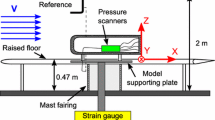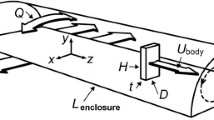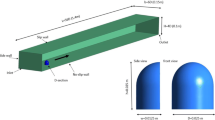Abstract
The time-resolved flow field in the wake of a rectangular bluff body in ground proximity is examined through wind tunnel experiments. In addition to an extensive assessment of the baseline wake dynamics, the study also investigates the impact of passive (i.e., base flaps) and active (i.e., fluidic oscillators) flow control on the wake dynamics. The velocity field downstream of the model is acquired with a stereoscopic high-speed particle image velocimetry system at several streamwise and crosswise sections. Coherent wake structures are determined by conditional averaging, spectral analysis, and spectral proper orthogonal decomposition. The baseline flow field is dominated by a wake bi-stability that is characterized by a random shift between two stable wake states. The bi-stability is governed by the model’s aspect ratio and occurs in the vertical direction, because the model height is 1.35 times larger than its width. Higher frequency modes with less energy content as determined in the appropriate literature are identified and visualized. A coupling between these modes and the bi-stability is discussed. Flow control has a significant impact on the wake dynamics. When passive flow control is applied, the bi-stability of the wake is still present for a flap angle of \(20^\circ\). The higher frequency modes are still detectable but weakened. The turbulence intensity is significantly reduced when the flow attaches to the base flaps and the bi-stability is inhibited. When active flow control is applied, the higher baseline frequencies are suppressed in addition to the absence of the bi-stability. Solely the dominant mode at a Strouhal number of about 0.08 remains present for all flow control configurations. This mode is attributed to an alternating shear layer oscillation.












Similar content being viewed by others
References
Ahmed SR, Ramm G, Faltin G (1984) Some salient features of the time-averaged ground vehicle wake. SAE Technical Paper (840300). https://doi.org/10.4271/840300
Barros D, Ruiz T, Borée J, Noack BR (2014) Control of a three-dimensional blunt body wake using low and high frequency pulsed jets. Int J Flow Control 6(1):61–74. https://doi.org/10.1260/1756-8250.6.1.61
Barros D, BorTe J, Noack BR, Spohn A (2016a) Resonances in the forced turbulent wake past a 3D blunt body. Phys Fluids 28(6):065,104. https://doi.org/10.1063/1.4953176
Barros D, BorTe J, Noack BR, Spohn A, Ruiz T (2016b) Bluff body drag manipulation using pulsed jets and Coanda effect. J Fluid Mech 805:422–459. https://doi.org/10.1017/jfm.2016.508
Barros D, BorTe J, Cadot O, Spohn A, Noack BR (2017) Forcing symmetry exchanges and flow reversals in turbulent wakes. J Fluid Mech 829:R1. https://doi.org/10.1017/jfm.2017.590
Brackston RD, Garcia de la Cruz JM, Wynn A, Rigas G, Morrison JF (2016) Stochastic modelling and feedback control of bistability in a turbulent bluff body wake. J Fluid Mech 802:726–749. https://doi.org/10.1017/jfm.2016.495
Cadot O, Evrard A, Pastur L (2015) Imperfect supercritical bifurcation in a three-dimensional turbulent wake. Phys Rev E 91(063):005. https://doi.org/10.1103/PhysRevE.91.063005
Cooper KR (1985) The Effect of Front-Edge Rounding and Rear-Edge Shaping on the Aerodynamic Drag of Bluff Vehicles in Ground Proximity. SAE Technical Paper (850288). https://doi.org/10.4271/850288
Duell E, George A (1999) Experimental study of a ground vehicle body unsteady near wake. SAE Technical Paper (1999-01-0812). https://doi.org/10.4271/1999-01-0812
Englar RJ (2001) Advanced aerodynamic devices to improve the performance. SAE Technical Paper, Economics, Handling and Safety of Heavy Vehicles. https://doi.org/10.4271/2001-01-2072
Evrard A, Cadot O, Herbert V, Ricot D, Vigneron R, Délery J (2016) Fluid force and symmetry breaking modes of a 3D bluff body with a base cavity. J Fluid Struct 61:99–114. https://doi.org/10.1016/j.jfluidstructs.2015.12.001
Garcia D (2011) A fast all-in-one method for automated post-processing of PIV data. Exp Fluids 50(5):1247–1259. https://doi.org/10.1007/s00348-010-0985-y
Grandemange M, Gohlke M, Cadot O (2013a) Bi-stability in the turbulent wake past parallelepiped bodies with various aspect ratios and wall effects. Phys Fluids 25(9):095,103. https://doi.org/10.1063/1.4820372
Grandemange M, Gohlke M, Cadot O (2013b) Turbulent wake past a three-dimensional blunt body. Part 1. Global modes and bi-stability. J Fluid Mech 722:51–84. https://doi.org/10.1017/jfm.2013.83
Grandemange M, Gohlke M, Cadot O (2014) Turbulent wake past a three-dimensional blunt body. Part 2. Experimental sensitivity analysis. J Fluid Mech 752:439–461. https://doi.org/10.1017/jfm.2014.345
Khalighi B, Zhang S, Koromilas C, Balkanyi S, Bernal LP, Iaccarino G, Moin P (2001) Experimental and computational study of unsteady wake flow behind a bluff body with a drag reduction device. SAE Technical Paper (2001-01-1042). https://doi.org/10.4271/2001-01-1042
Khalighi B, Chen KH, Iaccarino G (2012) Unsteady aerodynamic flow investigation around a simplified square-back road vehicle with drag reduction devices. J Fluids Eng 134(6):061,101. https://doi.org/10.1115/1.4006643
Krajnović S, Davidson L (2003) Numerical study of the flow around a bus-shaped body. J Fluids Eng 125(3):500–509. https://doi.org/10.1115/1.1567305
Li R, Barros D, Borée J, Cadot O, Noack BR, Cordier L (2016) Feedback control of bimodal wake dynamics. Exp Fluids 57(10):158. https://doi.org/10.1007/s00348-016-2245-2
Lucas JM, Cadot O, Herbert V, Parpais S, Dtlery J, (2017) A numerical investigation of the asymmetric wake mode of a squareback Ahmed body–effect of a base cavity. J Fluid Mech 831:675–697. https://doi.org/10.1017/jfm.2017.654.
Mason WT, Beebe PS (1978) The drag related flow field characteristics of trucks and buses. In: Aerodynamic drag mechanisms of bluff bodies and road vehicles, Springer, New York, pp 45–93. https://doi.org/10.1007/978-1-4684-8434-2_3
Pavia G, Passmore M, Sardu C (2017) Evolution of the bi-stable wake of a square-back automotive shape. Exp Fluids 59(1):20. https://doi.org/10.1007/s00348-017-2473-0
Perry AK, Pavia G, Passmore M (2016) Influence of short rear end tapers on the wake of a simplified square-back vehicle: wake topology and rear drag. Exp Fluids 57(11):169. https://doi.org/10.1007/s00348-016-2260-3
Peterson RL (1981) Drag reduction obtained by the addition of a boattail to a box shaped vehicle. NASA Contractor Report 163113
Schmidt HJ, Woszidlo R, Nayeri CN, Paschereit CO (2015) Drag reduction on a rectangular bluff body with base flaps and fluidic oscillators. Exp Fluids 56(7):151. https://doi.org/10.1007/s00348-015-2018-3
Sieber M, Paschereit CO, Oberleithner K (2016a) Advanced Identification of Coherent Structures in Swirl-Stabilized Combustors. ASME J Eng Gas Turbines Power. https://doi.org/10.1115/1.4034261
Sieber M, Paschereit CO, Oberleithner K (2016b) Spectral proper orthogonal decomposition. J Fluid Mech 792:798–828. https://doi.org/10.1017/jfm.2016.103
Van Raemdonck GMR, Van Tooren MJL (2008) Time-averaged phenomenological investigation of a wake behind a bluff body. In: Proceedings of bluff bodies aerodynamics and applications VI international colloquium
Volpe R, Devinant P, Kourta A (2015) Experimental characterization of the unsteady natural wake of the full-scale square back Ahmed body: flow bi-stability and spectral analysis. Exp Fluids 56(5):99. https://doi.org/10.1007/s00348-015-1972-0
Woszidlo R, Wygnanski IJ (2011) Parameters governing separation control with sweeping jet actuators. In: AIAA 2011, 29th AIAA Applied Aerodynamics Conference. https://doi.org/10.2514/6.2011-3172
Woszidlo R, Ostermann F, Nayeri CN, Paschereit CO (2015) The time-resolved natural flow field of a fluidic oscillator. Exp Fluids 56(6):125. https://doi.org/10.1007/s00348-015-1993-8
Acknowledgements
The authors would like to thank Moritz Sieber for supporting the data processing with the spectral proper orthogonal decomposition. This work is part of the research project ”Investigation of the Unsteady Wake behind a Generic Tractor-Trailer with Different Boundary Conditions” (PA 920/26-1). The authors would like to thank the German Research Foundation (DFG) for its financial support.
Author information
Authors and Affiliations
Corresponding author
Additional information
Publisher's Note
Springer Nature remains neutral with regard to jurisdictional claims in published maps and institutional affiliations.
Rights and permissions
About this article
Cite this article
Schmidt, H.J., Woszidlo, R., Nayeri, C.N. et al. The effect of flow control on the wake dynamics of a rectangular bluff body in ground proximity. Exp Fluids 59, 107 (2018). https://doi.org/10.1007/s00348-018-2560-x
Received:
Revised:
Accepted:
Published:
DOI: https://doi.org/10.1007/s00348-018-2560-x




